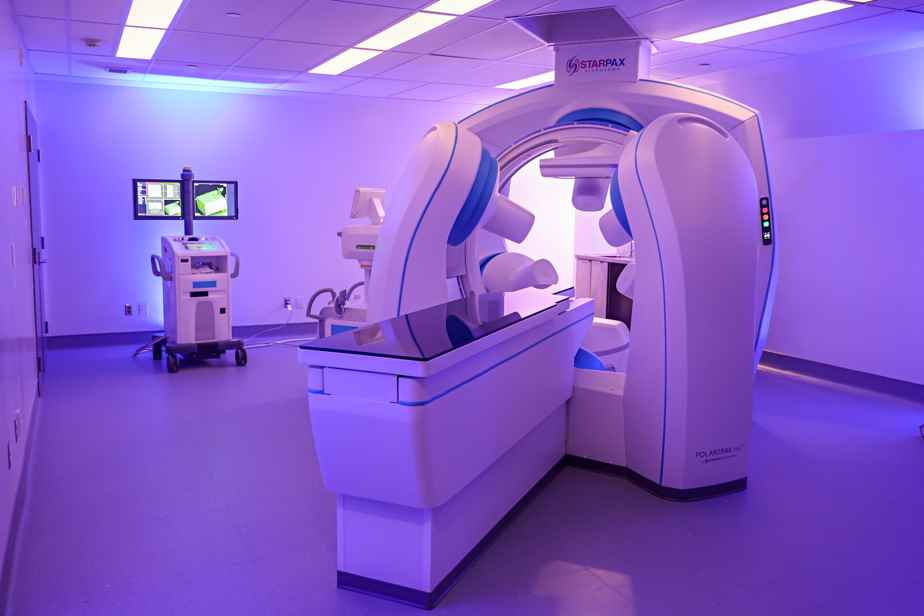In the basement of the Jewish General Hospital, a small room formerly dedicated to radiation oncology now houses an imposing machine, nicknamed the PolarTrak. It is here that patients will test an unprecedented therapy for the treatment of cancer from 2023.
Posted at 12:00 a.m.
This new research laboratory was inaugurated at the end of June by the Jewish General Hospital and the Quebec firm Starpax Biopharma. The concept ? Bacteria, on the surface of which drugs are attached, are injected directly into the tumor. These small organisms are guided by magnetic fields throughout its volume, in order to destroy it.
The first clinical studies planned on humans will focus on six types of cancer, namely cancers of the pancreas, prostate, head and neck, rectum, vulva and recurrence of breast cancer.
Make way for bacteria

IMAGE PROVIDED BY STARPAX
Bn1-S bacteria on the surface of which drugs are attached.
The bacterium called Bn1-S is at the heart of this new technology. This organism, developed in the laboratory thanks to more than 800 mutations, is sensitive to magnetic fields, which makes it possible to control its trajectory with millimeter precision.

IMAGE PROVIDED BY STARPAX
The patient is positioned in the PolarTrack so that the tumor is at the crossroads of the magnetic fields.
The bacteria are injected by endoscopy through the mouth, through the rectum or by injection through the skin: an intervention of about ten minutes. During the injection, the patient is positioned in the PolarTrack so that the tumor is at the point of convergence of the magnetic fields.
-

IMAGE PROVIDED BY STARPAX
The tumor and its hypoxic areas (dark red ring)
-

IMAGE PROVIDED BY STARPAX
Bacteria naturally move to hypoxic areas
1/2
The magnetic fields then travel through the tumor, distributing the bacteria throughout its volume. The drug, which is on the back of the bacteria, is gradually released into the tumor. It therefore does not circulate in the blood system. Since toxic agents do not spread throughout the body, side effects caused by traditional treatments are greatly reduced.
Lack of oxygen
The bacteria, which do not need blood vessels to move around, are able to enter the hypoxic areas of the tumor, where the oxygen level is low. This ability is an undeniable advantage in overcoming cancer.
This is because cancerous tumors have lower oxygen levels compared to normal tissues. In this environment, cancer cells proliferate rapidly, consuming almost all the oxygen around them to form a barrier, called the hypoxic zone.
This environment is favorable to them, since it allows them to better resist drugs, standard treatments and attacks from the immune system.

PHOTO FRANÇOIS ROY, THE PRESS
Michel Gareau, President and Founder of Starpax Biopharma
The blood vessels don’t get to these hypoxic areas, so no matter how much you invent the best drug in the world, it doesn’t get there.
Michel Gareau, President and Founder of Starpax Biopharma
However, Starpax bacteria manage to enter these hypoxic areas naturally, since the oxygen level is the same as that of their culture medium.
After 60 minutes, the bacteria die because the human body temperature is too high for them to survive. But the drugs that were on their surface continue their attempt to destroy the cancer cells.
Beginning of studies
So far, the technology has been tested in preclinical studies in animals, such as monkeys, mice, dogs and pigs. “We had a 100% remission ratio without side effects,” rejoices Mr. Gareau, who is eager to begin clinical studies. “We don’t expect failure,” he says.

PHOTO FRANÇOIS ROY, THE PRESS
The new research laboratory was inaugurated at the end of June.
The Ministry of Economy and Innovation has granted funding of up to $7 million for the establishment of the PolarTrak room.
“This new room at the Jewish General Hospital will make it possible to innovate thanks to avant-garde treatments, in addition to creating direct spinoffs on the dynamism of research in Quebec,” declared Pierre Fitzgibbon, Minister of the Economy and of Innovation and Minister responsible for Regional Economic Development, at his inauguration.
Quebec innovations against cancer
Other researchers are actively working to revolutionize cancer care and early detection. The Press presents some current projects.
A bra that saves lives
A professor and researcher from the University of Sherbrooke, Elijah Van Houten, wants to develop an easy and practical way to screen for breast cancer at home. His team is working to develop a bra capable of detecting small breast tumours. He is using cutting-edge technology to build a prototype bra that can detect changes in breast tissue in the event of a tumor. Unlike a mammogram, the bra would be painless and portable. This technology could also help detect recurrences of breast cancer, so they can be detected and treated earlier.
Towards a cure for lymphoma
Tarik Möröy, a researcher at the Montreal Clinical Research Institute (IRCM), discovered with his team that a specific enzyme is necessary for the development and progression of lymphoma, a cancer that affects a type of white blood cells. These experiments showed that a mouse that develops lymphoma does not get sick or develop the disease later in life when the DDX3 gene is knocked out. The team in Möröy’s lab now wants to test drugs with the aim of reducing the dosage of this enzyme, and therefore the serious side effects of lymphoma treatment.
Detect melanomas
The incidence rate of melanoma — one of the most serious forms of skin cancer — is increasing rapidly worldwide, but its detection and treatment at early stages requires invasive and imprecise methods. Jinyang Liang, a researcher at the National Institute for Scientific Research, and his team are developing a platform to diagnose and treat melanoma at an early stage. Their approach combines nanomaterials, microtechnology and ultra-fast imaging to determine the type of lesion based on heat exchanges on the skin.

